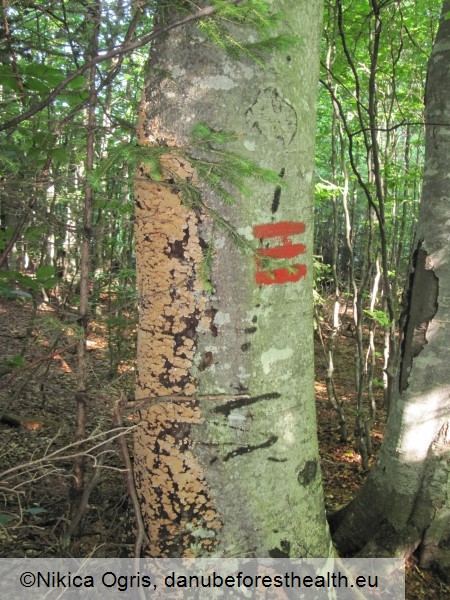Fungi
Stereum canker
Stereum rugosum
Nikica Ogris, Thomas Cech
|
|

Fig. 1. Canker on oak caused by Stereum rugosum

Fig. 2. Canker on beech caused by Stereum rugosum

Fig. 3. Fruiting bodies of Stereum rugosum
DETECTION PERIOD:
Whole year
DESCRIPTION:
Symptoms of this disease are flask- or club-shaped swellings and mostly one-sided depressions in the lower part of the stem. Later on, the bark splits and dies. The infection usually starts from a dead branch stub which is usually located in the centre of the lesion (Fig. 1). The most obvious indication of the presence of a Stereum canker is the appearance of the closely appressed, irregularly shaped, crust-like fruit bodies on the killed bark (Fig. 3). They are grey-brown, later ochre and their multi-layered hymenium becomes stained blood red when injured (thus an old synonym is Haematostereum rugosum). Their surface is initially smooth, becoming cracked with age.
HABITAT:
On oaks (Quercus sp.), beech (Fagus sylvatica), and also hornbeam (Carpinus betulus) at warmer sites with ample rainfall and high relative air humidity.
STATUS:
Widespread in the Danube region but with relatively low frequency.
IMPACT:
Causes perennial canker – the margins of wound tissue formed by the tree are repeatedly killed by the fungus during the dormant season so that a broad, open lesion develops. In the vicinity of the lesion, a white rot also appears, but this is demarcated by an effective reaction zone and so usually penetrates only a short distance into the softwood.
SIMILAR SPECIES:
Other species of Stereum, e.g. S. sanguinolentum, which has an epidermis of yellowish grey, and grows exclusively on conifers; S. gausapatum, has a generally curved surface and is found on oak barrels.
|